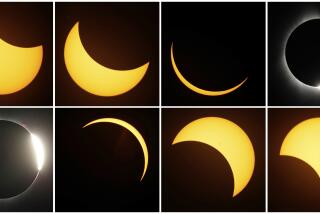Don’t believe the light: Supernova in ‘Einstein Cross’ is a cosmic trick
An exploding star goes supernova only once. But if you’re really, really lucky, you might just get to see it happen four times.
An international team has discovered four separate images of the same distant supernova arranged in the shape of a cross — and this unusual trick of the light could help scientists test the structure of the cosmos. They reported their find in Friday’s edition of the journal Science.
The formation of the four supernova images, in a shape known as an Einstein Cross, had been predicted half a century ago by Sjur Refsdal, a Norwegian astrophysicist who died in 2009. The new supernova is named SN Refsdal in his honor.
Though Refsdal did not live to see the discovery of this Einstein Cross, “he’d be delighted,” said Caltech astronomer Richard Ellis, who met Refsdal years ago. “It’s just beautiful imaging. It’s almost like a piece of art; you look at the image and there’s no question what’s going on.”
SN Refsdal sits about 9.3 billion light-years away, and at that distance it should be very difficult for our telescopes to make out. Luckily, the supernova is about 20 times brighter than it should be, thanks to a phenomenon known as gravitational lensing.
Here’s how it works: About halfway between SN Refsdal and Earth lies a huge galaxy cluster, about 5 billion light-years from us. This cluster is so massive that its gravity bends the light from the supernova rather like a magnifying glass would, amplifying the distant exploding star enough for scientists to pick it out.
“Basically what we’ve been doing is [trying] to use 10 very massive galaxy clusters as natural magnifying glasses to study very distant faint galaxies that are ... otherwise inaccessible with today’s telescopes and instruments,” said UC Berkeley astronomer Patrick Kelly, the study’s lead author. Kelly is part of the Grism Lens-Amplified Survey from Space project, which uses such gravitational lenses to explore the distant cosmos.
But while many of the team members were interested in different galaxies, Kelly had a special interest in supernovas — the
powerful flare-ups of dying stars.
“I was searching the data … and I spotted this spectacular pattern which I frankly hadn’t been expecting to see,” he said. “We didn’t even consider the possibility that we would see such a dramatic configuration.”
SN Refsdal is even further lensed by a massive red elliptical galaxy in the cluster that happens to be sitting in just the right spot between Earth and the supernova. The combined effect from both the cluster and this well-placed galaxy is that SN Refsdal isn’t just extra-bright — its image is also multiplied four times.
Because the light in each image follows a different route, they each take a different length of time to show up on Earth. So the four images of the supernova flared into existence one at a time, each within a few days of the other.
“The unique thing here is that this is a transient object that’s being lensed,” said UC Berkeley astrophysicist and study coauthor Alexei Filippenko. “It only lasts for a few months, or for a year or so. It doesn’t last for millions of years like a quasar. And that means that as the thing brightens and fades, we should actually see — and we are seeing this in the data — the four different images brightening and fading at different times.”
This is invaluable information, Filippenko said, because it allows the researchers to investigate how much invisible dark matter is in the galaxy cluster, and what the structure of the dark matter is. For example, if one supernova image takes longer to reach Earth than the others, then there must be considerable mass warping its path.
Dark matter makes up 84.1% of the matter in the universe, but it can’t be seen or felt at all. Thus far, the effects of gravity have been the only clear giveaway of its existence.
“The cool thing about that is that by measuring when these different images brighten and fade, we can get a better handle on the amount and distribution of dark matter,” Filippenko said. “We’re still trying to find ways to probe the nature and distribution of dark matter, and this gives us an excellent laboratory with which to do so.”
The scientists don’t think this is the first time the supernova has appeared. Computer modeling shows that RN Refsdal could have shown up decades ago — and it’s quite possible that another image will reach us in the next one to 10 years, the scientists said. While that may sound like a huge delay, a few decades is nothing compared with the 9 billion years the light has traveled in total.
Being able to capture this fleeting event again and again could help the scientists gain an even better understanding of the structure of dark matter in the galaxy cluster’s neighborhood.
“It’s a beautiful demonstration of the power of gravitational lensing,” said Ellis, who wasn’t involved in the study.
However, such an exquisitely lensed supernova is exceedingly rare, which means exploding stars like this one may not turn out to be a practical tool, Ellis said. Even if the astronomers do keep looking for SN Refsdal’s reappearance in the next decade, it might be hard to get enough telescope time to catch it again.
amina.khan@latimes.com
Twitter: @aminawrite
ALSO:
Mysterious Martian haze baffles planetary scientists
Prepare to be blown away by this picture of comet Lovejoy
Mars once had an entire ocean -- and then lost it, scientists say







